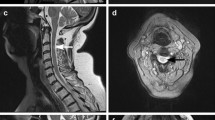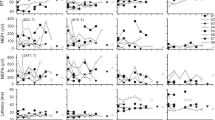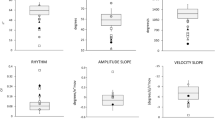Abstract
The clinical and neurophysiological findings in a patient with a typical stiff-man syndrome and their three-year evolution are described. The patient had high titers of anti-glutamic acid decarboxylase antibodies in both serum and cerebrospinal fluid. Magnetic resonance imaging (MRI) of brain and spinal cord was normal. Transcranial magnetic stimulation (TMS) revealed a distinctive motor evoked potential (MEP) pattern in proximal lower limb muscles consisting of markedly increased MEP amplitudes and MEP/M ratios, reduced excitability thresholds, and absent silent period. However, MEP latencies, central and peripheral conduction times and amplitudes obtained by magnetic spinal root stimulation were normal. Treatment with benzodiazepine and baclofen normalized both the clinical picture and the MEP values. TMS may be useful both as a diagnostic tool and to monitor the response to drug treatment.
Similar content being viewed by others
Author information
Authors and Affiliations
Additional information
Received: 27 November 1998 / Accepted in revised form: 2 April 1999
Rights and permissions
About this article
Cite this article
Logullo, F., Di Bella, P. & Provinciali, L. Motor evoked potentials in a case of stiff-man syndrome: a longitudinal study. Ital J Neurol Sci 20, 133–138 (1999). https://doi.org/10.1007/s100720050021
Issue Date:
DOI: https://doi.org/10.1007/s100720050021




